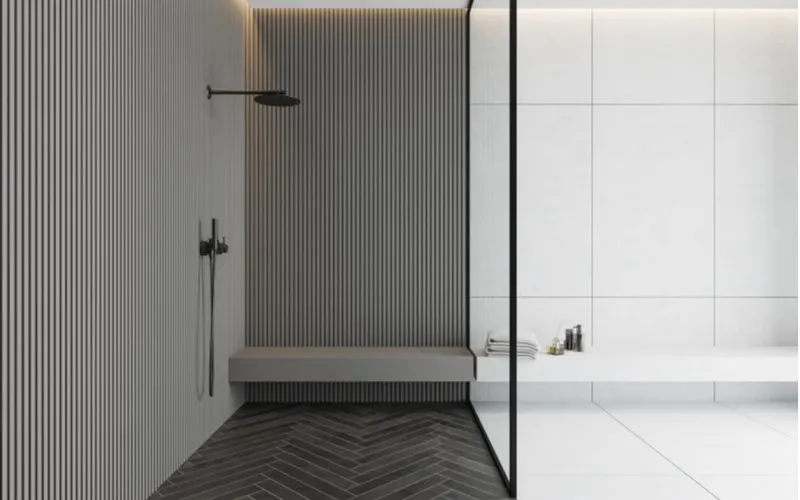A practical way to upgrade your shower stall is by adding a floating shower bench.
Instead of using a freestanding bench, these floating benches look like part of the design.
You can even install them in an existing bathroom.
Seating and Storage Space
A standard shower bench gives you a place to sit while you bathe. You might use it to prop up your feet when you shave your legs or to keep yourself from slipping in the water.
A floating shower bench offers all this and more. There are no legs beneath a floating shower bench, so it blends into your shower.
A floating shower bench doesn’t take up as much of your shower space as a built-in bench. There is still accessible space underneath the bench you can use for storage. The lines of a floating bench keep your shower design looking streamlined.
Installing a Floating Shower Bench

Artazum/Shutterstock
There are many things to think about if you want to add a floating shower bench to your bathroom. Many of these aspects depend on your bathroom aesthetic and how much space you have.
Regardless of your shower’s size, a floating shower bench ensures you’re not losing storage space. Many people think the built-in shower benches are sturdier because they’re solid. But floating shower benches can support at least 400 pounds of weight.
They’re also flexible in terms of installation. You can drill them into place and tile over them, or you can use special brackets to keep them in place until you decide to move them.
Dimensions
The size of your floating shower bench depends on what you’re looking for. If you want a comfortable bench, you’ll want to go with a larger size. Most shower benches have a width of at least 14 inches, though many are as wide as 36 inches.
The depth of the seat is usually set at 15 or 16 inches wide. This measurement is a recommendation set forth by the Americans with Disabilities Act (ADA). They found that this depth is accessible for most people.
It’s deep enough to sit comfortably without making it hard to get up. A deeper seat might make you slide back towards the shower wall. You’d have to maneuver yourself carefully to the edge of the seat to stand.
In a slippery environment, this could lead to people slipping and hurting themselves. The ADA also found that the optimal height for shower benches is between 17 to 20 inches off the ground.
At this height, most people can sit with their feet flat on the floor. If your feet aren’t on the floor while you’re sitting, you’d have to jump a little to get up. Again, this isn’t a movement you want to make in a slippery shower stall.
Design
For people with a walk-in shower, you have a lot of freedom when it comes to your floating shower bench design. You can keep it at the end of the stall or have it span the long wall.
You can choose to install a floating shower bench with a hinge if you don’t have much space in your shower. The hinges let you fold the bench out of the way when you don’t need to sit down. A corner floating shower bench is another choice for small spaces.
These benches usually come in triangular shapes, so they fit in the corner and help you make the most of your available space.
They’re wider at the front and narrower at the back, but they’re still comfortable options. You want to place the bench so the water from the showerhead can reach you no matter what.
It’s nice to have a shower bench so you can sit and enjoy the shower. Still, you want the option of getting clean from this perch as well. Wheelchair users might choose to position the bench close to the edge so they can get in easily.
It’s also a good idea to place the floating shower bench near a wall where you can install grab bars as well. These bars benefit wheelchair users, the elderly, and anyone who feels unsteady on their feet.
Materials
More popular choices include a variety of stones. Granite, marble, and quartz hold up well in the wet and humid shower environment. They also look great with various shower walls and tiles.
Some floating shower benches are wood, though you have to choose the right type. Even when treated with sealant, wood can rot when exposed to so much water and humidity. Teak is a robust and sturdy wood option, and it’s water-resistant.
If you choose a stone floating shower bench, you can get a solid slab. With wood, you’d most likely get slats that wouldn’t be as comfortable.
It’s possible to get a wooden slab for a bench, but again, you have to consider how it might splinter and rot in the water.
Cost
Installing a floating shower bench is more affordable than a built-in shower bench because it doesn’t require much hardware. All you need are brackets, screws, and the bench itself. You can do much of the work yourself.
Even if you hire a professional to install it for you, it’s not expensive. A built-in shower bench, on the other hand, costs a lot because you need a professional.
There are more materials required, which means that that expense will be higher, too.
Things to Consider

ImageFlow/Shutterstock
Knowing all of the factors that go into making a floating shower bench suitable for you gives you a good start. But you need to consider a few more things before investing in this shower upgrade.
- It’s easy to install floating shower benches. They call for special, sturdy brackets that you screw against the wall and attach to the bench seat.
- Floating shower benches don’t take up all of the shower stall space that a traditional built-in does. You still have an area below the bench to store your bath products and keep them out of sight. It also gives you more legroom since you can tuck your feet under the bench.
- Hinged floating shower benches give you even more space. They fold out of the way when you’re not using them, so you can have your whole shower space.
- You can use different materials for floating shower benches, such as granite, marble, and quartz. While you can use wood, you want to choose something water-resistant, like teak.
How much weight can a floating shower bench hold?
A standard shower bench can hold anywhere from 200 to 500 pounds, depending on the model. By design, floating shower benches must support at least 400 pounds.
When you install the bench, you’ll get special brackets. A floating shower bench bracket set supports a minimum of 400 pounds.
They usually max out at 600 pounds. Brackets carry most of the weight, but you want to ensure you get a bench made from sturdy material as well.
Teak is a sturdy choice of wood for a floating bench, but stone like granite, marble, and quartz will hold up better against water and weight.
Do you tile under a floating shower bench?
When you install a floating shower bench, you have several options when it comes to tiling. If you’re covering the bench in tile, you should tile that first.
Doing this ensures your tile will match up when it meets the wall. If you’re installing a floating shower bench in an existing shower stall, you won’t have to tile.
You can install the brackets and put the bench in place against the tile wall. For those who are building a new bathroom or completely upgrading their shower, yes, you should tile under the floating shower bench.
You can tile the wall as you’d typically lay tile in a bathroom, taking care to ensure the edges line up around the bench.
Can you install a floating shower bench in an existing shower?
Yes, you can install a floating shower bench in an existing shower. You can take care to make it look like it was part of the original design.
When done correctly, it will give a seamless look to your shower, and no one will know you added it later. The biggest concern when adding a floating shower bench in an existing shower is to ensure it can handle a person’s weight.
A floating bench should hold at least 400 pounds. Most of this strength comes from the brackets you install against the wall.
Closing Thoughts

ThomasPhoto/Shutterstock
A floating shower bench not only gives you more storage space compared to a built-in shower bench, but they’re also more affordable.
These benches aren’t hard to install, even in an existing bathroom. A floating shower bench is as sturdy as a built-in option if you install it using suitable bench materials and special brackets.

